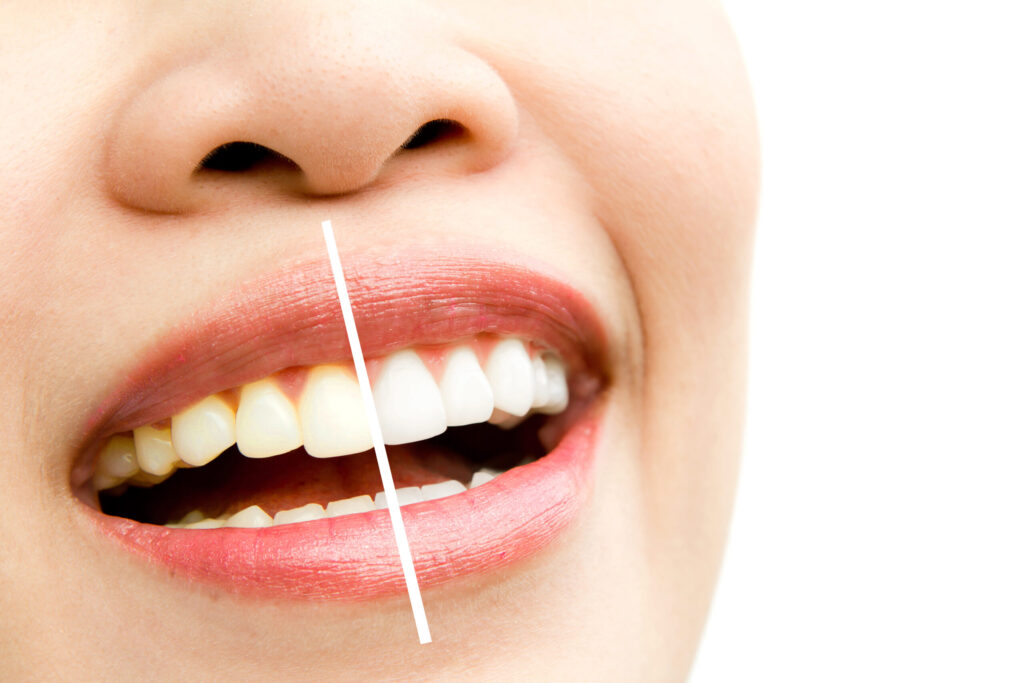Teeth Whitening
Whitening just made easier
Ever been curious about teeth whitening but not quite sure what to expect? Don’t worry; you’re in good company! Here are the top 5 things you should know before taking the plunge into the world of beauty.
How does it work? Will it harm your teeth?
Contrary to what many people think, teeth whitening doesn’t thin your enamel or harm your teeth at all! The key active ingredient in teeth whitening products is a chemical called hydrogen peroxide or urea peroxide. Here’s how it works: When hydrogen peroxide oxidizes, it breaks down and releases free radicals that work to break up stains on your teeth into smaller molecules. These smaller molecules have a greater surface area, which reflects more light and gives you a brighter smile! So, no need to worry about your enamel—it’s safe and effective.
Why are my teeth stained? Is whitening effective?
The improvement of tooth discoloration depends on its underlying cause, and there are various options available besides teeth whitening.
- Intrinsic staining, which becomes a part of the tooth during its development or after eruption, can be challenging to address solely through whitening.
- If your teeth appear white and chalky due to a condition called fluorosis, often caused by excessive fluoride ingestion, treatment options can include whitening, ICON resin infiltration, micro/macro abrasion, or veneers, depending on the severity.
- On the other hand, multi-colored or two-toned teeth resulting from factors like tetracycline staining due to medication are particularly difficult to whiten effectively.
- Extrinsic staining, which involves food particles binding to the layer of plaque on the tooth’s surface as well as microscopic cracks and fissures, is relatively easier to remove.
- Common culprits like coffee, tea, artificially colored foods, and tobacco can stain your teeth.
- Chairside teeth whitening, especially, tends to be more effective against mild to moderate extrinsic staining compared to over-the-counter products. Consult with a dentist to determine if you are a suitable candidate for these treatments!

Can I Do Whitening At Home?
Certainly, you have the option to whiten your teeth at home using a whitening kit, but it’s worth noting that chairside or in-office whitening tends to be more effective. This heightened effectiveness can be attributed to the significantly higher concentration of hydrogen peroxide (ranging from 20% to 35%), a level only permitted for application by dental professionals. With proper care, the whitening effect from chairside treatment can last up to three years, provided you take precautions such as avoiding tobacco, coffee, or tea.
If you prefer the convenience of at-home whitening, it’s advisable to consult with a dentist beforehand. They can provide you with a pre-fabricated or custom-made tray and offer guidance on applying the whitening gel as per the instructions. Typically, this process takes around 1 to 2 hours (some products allow overnight application) and can be repeated until you achieve your desired shade. The downside, however, is that this method can be time-consuming, with results becoming noticeable over the course of a week.
In comparison, professional teeth whitening performed by dental experts is more efficient. It usually requires only about 15 minutes of application and can be repeated until you’re satisfied with the outcome. The results become readily apparent within just one hour.
It’s important to emphasize that any type of teeth whitening product should be used after consulting a dentist. This ensures the product’s safety and that the procedure is closely monitored by professionals.
How long does it last?
It’s common for the whitening effects to gradually recede in shade following treatment. This natural process is typically slow, but exposure to various staining agents can accelerate it.
To help maintain the brightness of your teeth for an extended period, it’s advisable to steer clear of the following items: coffee, tea, colas, all tobacco products, mustard or ketchup, red wine, and any food or beverages containing colorings. Additionally, using a take-home tray for maintenance or incorporating whitening toothpaste into your routine is recommended.
What are the side effects of teeth whitening?
One of the most common issues experienced after teeth whitening is tooth sensitivity. In fact, about 75% of patients may encounter varying degrees of sensitivity, especially when their teeth come into contact with cold beverages.
Fortunately, this sensitivity is temporary and typically lasts for up to three days. It doesn’t pose any significant harm to the pulp, which contains nerve endings in your teeth. You can minimize this sensitivity by using anti-sensitivity toothpaste containing ingredients like potassium nitrate and sodium fluoride.
In some cases, gum irritation may occur if the whitening gel seeps through. However, this effect usually resolves itself within three hours. Overall, chairside teeth whitening products are approved by the Ministry of Health and are considered safe for application every 6 to 12 months.

